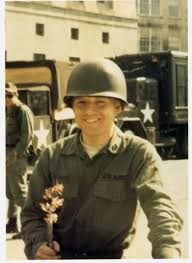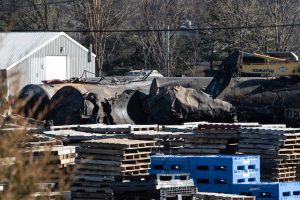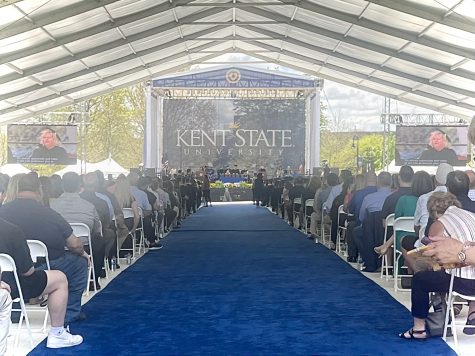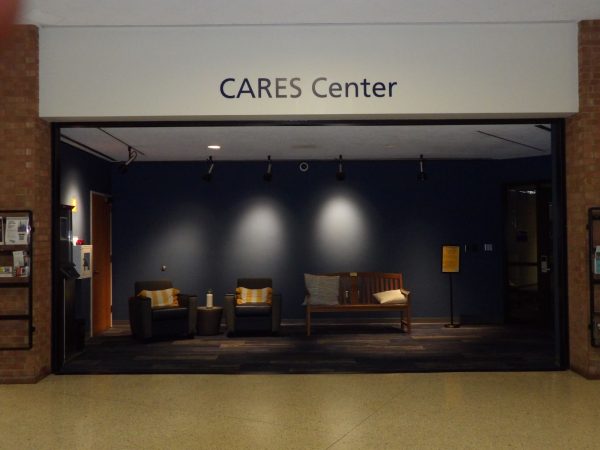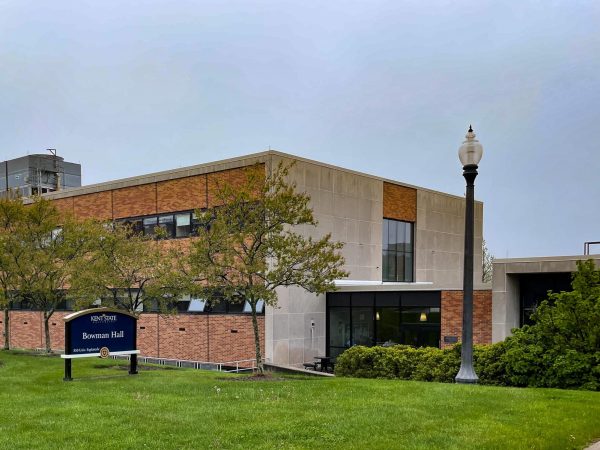The history of Kent
June 28, 2017
The story of Kent begins in 1790 with Capt’n Brady.
Brady — often revered as an iconic symbol of Kent history — was in all reality a Native American killer, whose famed jump across the Cuyahoga River was the result of being chased by Native Americans seeking revenge — not a heroic race.
As the story goes, Brady landed on the other side of Cuyahoga and fled to a nearby lake, which now bears his name. Capt’n Brady has been the source of inspiration for several other once-landmarks in Kent including Capt’n Brady’s, a coffee shop that stood where Starbucks on East Main Street does now, and Brady Lake Village, which recently dissolved.
Shortly after Capt’n Brady’s leap, the Haymaker family arrived to what would soon become Franklin Mills. Jacob Haymaker originally bought the land from Aaron Olmsted, but unable to return to settle the town himself, he sent his son, John. John and Sally Haymaker were the first settlers of what they named Franklin Mills but what would later become Kent.
In 1807 the Haymakers built the first mill, planning to create a settlement based around the Cuyahoga River and the resources it provided. They were successful and their investment in the mill, as well as the growing community, lured Zenas Kent to Franklin Mills.
Zenas Kent — a successful businessman from Ravenna — saw a future in Franklin Mills. Zenas had 13 sons, including Marvin and William, who became prominent members of the history of Kent. Zenas partnered with John Brown and began building several new buildings throughout the city including a tannery, which has since been turned into Tannery Park.
Zenas was also responsible for the construction of the Kent National Bank, of which he was the President, as well as cotton mills and a flour mill. During the boom of Franklin Mills, Zenas sold much of the land he owned to the Franklin Land Company, a group of investors and capitalists, whose biggest idea for the city was the addition of a silk mill.
The silk mill, whose building still stands on the other side of the Cuyahoga River, failed once it was realized that the silkworms could not survive in the Northeastern Ohio climate.
Marvin Kent, someone artist Henry Halem described as “prescient,” foresaw the importance of having a thriving railroad. He believed it was the key to connect Franklin Mills to the rest of the country.
The track for the railroad was laid in 1853, although it took 10 years before the first train came through. At that point in time, the A&GW Rail Yards — built by Marvin Kent — employed one in every three people in the town. Because so much of town was employed by Marvin Kent, and because he had been the force behind a lot of the growth in the city, the town was renamed from Franklin Mills to Kent, after Marvin Kent.
The depot, which still stands as a historic landmark in Downtown Kent and is now owned by the Kent Historical Society, was built in 1875. When the two-story building opened, its first floor featured ticket offices, a dining room and a kitchen, while the second floor held living quarters for the owner of the restaurant.
After the railroad business came to an end for Kent, the depot was abandoned and would have been demolished if not for the Kent Historical Society purchasing the building in 1975. Previously the building housed the restaurant Pufferbelly, but recently, renovations began to turn the depot into the home of a new Italian restaurant.
Shortly after the depot opened, the Main Street bridge construction began in 1877. The bridge, which is over 120 years old is one of the only stone bridges left standing in Ohio. Again, Halem said Marvin Kent had the forward-thinking necessary to do things a little bit differently. While most stone bridges in the state of Ohio were at most 30 feet wide, Marvin ordered the Main Street bridge to be 60 feet wide. Halem said if they hadn’t made it so wide, it would’ve been gone a long time ago.
The bridge is made of stone “casing” and filled by debris and the leftovers from demolition, which were poured inside in order to fill the casing.
John Davey arrived in Kent in 1881 after being commissioned to construct what is now Standing Rock cemetery. Standing Rock, a historical landmark in Kent located in the center of the Cuyahoga River, has been a piece of Kent history since before the Haymakers. Davey was also the founder of the Davey Tree company, which planted hundreds of trees around the community. His son, Martin L. Davey, would go on to be a prominent political figure from Kent.
The Opera House, constructed in 1889, hosted traveling entertainers, magicians, silent films and eventually “talkies”. However, due to financial restraints and changing entertainment preferences, the building was abandoned in the 1950s and eventually demolished in 1964 to make way for a parking lot and eventually what is now the Hometown Bank drive-thru.
The Twentieth Century: Education Comes to Town
In 1901, at the peak of his philanthropic giving Andrew Carnegie gave a $10,000 gift to the city of Kent to be used to build a public library. Marvin Kent offered the land and that library, now known as the Kent Free Library, has since added on expansions and grown but remains a free public space for the community
In 1910, the city of Kent took its first steps towards becoming a college town. William Kent, a son of Marvin Kent, sold the land to the state of Ohio to build Kent Normal College, a teacher’s training school and what would become Kent State. The story, an interesting one, has been told many times over the years.
Martin L. Davey, the son of John Davey, was elected the mayor of Kent in 1913. He went on to be elected (and re-elected) to the House of Representatives in 1918, and eventually became the Governor of Ohio in 1934.
In 1913, the city of Kent had a major flood, one of the first to be captured on camera. The floods, a result of the nearby river, were a contributing factor to the way property was purchased and owned by different people within the economic sector. The houses that stood on higher ground, such as the row of homes at the top of the Main Street hill, were reserved for the most wealthy in the community. The homes, majority of which are currently occupied by fraternities, are the original homes that stood in the 1900s.
In the 1920s came a boom of development and growth for downtown Kent. The Franklin Hotel was constructed in 1920. The hotel saw many different owners, one of whom, Cornelius P. Patchin, died in an elevator malfunction. Eventually, in 1979 the hotel was condemned and remained vacant until recently. The city of Kent purchased the property, sold to Ron Burbick who refurbished the space, including adding in Buffalo Wild Wings to the lower floors.
In the same boom, the Kent Theatre began to take shape. Originally built to be a modern movie place, the theatre has since become the home of the Kent Stage. The Kent Stage, which opened its doors in 2002, found it’s place in Kent following the emergence of the Folk Festival — an annual Downtown Kent event. The venue has since seen big names come through and hosts a production of Rocky Horror Picture Show every year.
As Kent State began to grow and take shape, the community followed. Halem said there are direct ties between education available and economic benefit a city experiences.
“As professors and students came and the economic base grew, which is why the economic base today is so great,” Halem said. “The power of education is directly tied into the economic well-being of any city.”
The university saw a massive amount of expansion in the 50s and 60s, following the post-war boom. Students flocked to the university and in turn, filled the town with new consumers. It was at this point in time that businesses like Ray’s Place began to take shape and become iconic marks of the town.
In 1972, Kent saw one of its’ most historic fires to date. The Kent Block — a series of buildings constructed by Marvin Kent — fell to the blaze, which burned the entire block to the ground. In its place now is the Hometown Bank Plaza, the only corner of the four-way intersection of Main Street and Water Street that does not house the original building.
The landscape of downtown Kent has been shifting for years, metamorphosing dive bars into empty lots and other streets into blocky retail strips. Its identity, to those who have watched it change, however, is more contested.
Acorn Alley, a draw for many college students, didn’t open until 2009. The Lester A. Lefton Esplanade — the brick-paved pathway that connects front-campus area shops and streets downtown — didn’t guide students and pedestrians until 2013. The changes current and past students have seen, however, seem small compared to the changes university alumni have witnessed.
The Kent of 2017 may look different than the Kent of 2010, but the transformation throughout the years, as alumni Phil Soencksen noted, goes far deeper than the city may let on.
“Downtown was kind of gross,” Soencksen said. “Really, there weren’t really good places to eat. There was the Pufferbelly, but that was the kind of place you went with your parents when they came in from out of town. But there wasn’t really a lot of stuff to take your parents to, and the places were gross.”
The next big expansion of Downtown Kent has been recent — beginning in 2007, when strategic plans to revitalize the community began to take shape. Dave Ruller, the city manager, said that several surveys were conducted over the years and the answer almost always came back the same: Kent residents wanted to see a revitalized Downtown Kent.
At the time of the 2007 survey and formulation of a strategic plan to bring new life to Downtown Kent, Lester Lefton took office as the president of Kent State and brought with him an ambitious goal to take on the downtown area and leave a lasting impact. Ruller said Lefton was a good cheerleader for the project, and led the charge for getting the university involved in the overhaul of Downtown Kent.
Though it didn’t come without twists and turns, Ruller said one of the biggest successes of the strategic plan and redevelopment came from making an effort to change the community effort, and being willing to spend money to make money.
“We really tried to get this consistent message across to rally around your community,” Ruller said. “It was a risk to spend this money and acquire the land, but the interesting thing about a financial crisis is that people are more willing to take risks and be bold.”
The revitalization, which found some inspiration from similar college towns such as Normal, Illinois, the home of Illinois State University, was completed based on an agreement between the city of Kent, Kent State and a developer. A prominent private investor, Ron Burbick, also took part in the project.
Burbick, the head of the Phoenix Project, was the benefactor of a $6.5 million project that brought Acorn Alley to Kent. He is also the owner of the previous Franklin Hotel, which now houses Buffalo Wild Wings. Burbick purchased a large portion of East Main Street, and restored the first floors, as well as adding second floors to many of the buildings.
“If I were a parent of a student or just an adult or an older student coming to Kent, thinking about coming here for school and saw the old downtown, I’d be disappointed. Very disappointed,” he said. “Because when I was a student I didn’t really know about downtown because I was underage and everything else, and it was fun because I was a dumb kid, but I think students are a little different now, and I think parents are a little different now.”
Not all Kent alumni agree though, like Leatrice Bard Tolls, ‘92.
“What occurs to me is there are so many new restaurants and stores. There’s too many of them to actually be supported by the people that live here, and so none of them are given enough audience, if you will, to sustain them,” she said. “I’m seeing too many things that (have) just opened gone already — in (pre-fabricated) buildings that don’t make me feel warm and fuzzy when I come home.”
As Kent’s downtown and Kent State’s campus continues to grow and change, as it has throughout its lifetime, its identity — the feeling of the quintessential Kent — may depend on the feeling of its residents, students and alumni. Margaret May, ‘96, notices the old and the new, and said she thinks the changes are relatively positive.
“I can still walk along front campus and see the rock and see the facades of all of the buildings that I had classes in, but I can see the new stuff too and know that, ‘Okay, so there’s students here now, and they’re having the same academic experience that I did, and they’re having the same experience as far as being away from home for the first time, and making new friends and meeting new people, and they’re doing it on the same grounds that I was on, but there’s all this new stuff here now too, to kind of keep up with the times,’” May said. “And I think that’s great. I think the only way a place survives is if it keeps up with the times.”
Kaylee Peterson is the downtown reporter, contact her at [email protected].
Cameron Gorman is a senior reporter, contact her at [email protected].








